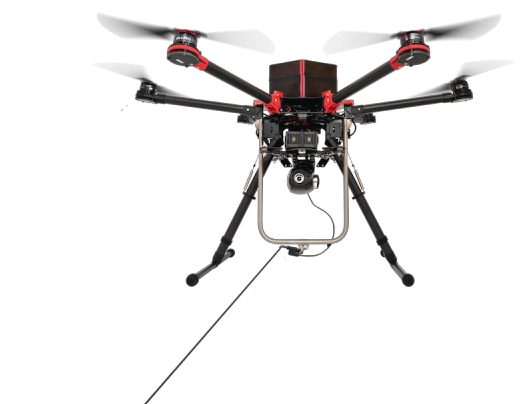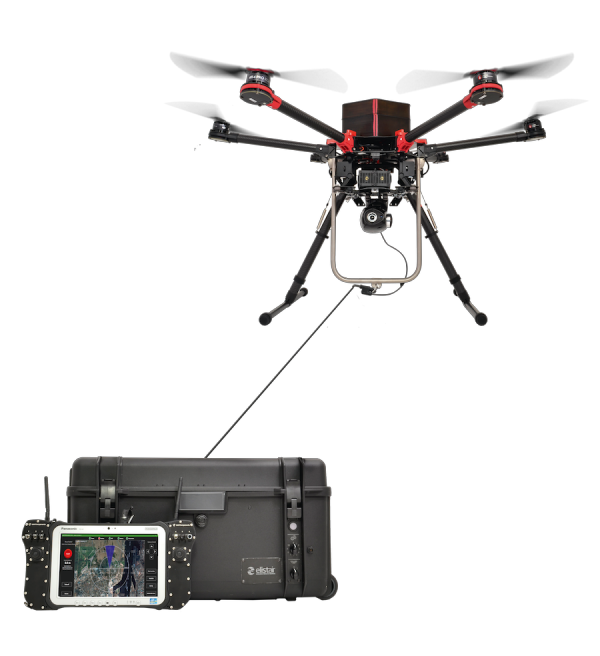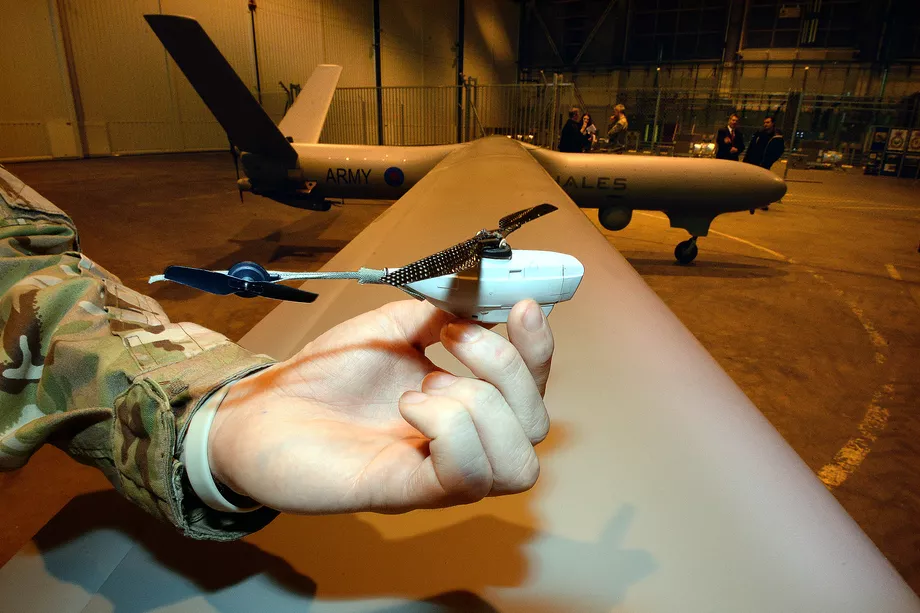Keith Mann faces the same problem each year: frost.
The icy condensation is detrimental to his crop in Buzzards Bay, Massachusetts, the birthplace of the modern American cranberry industry. As the temperatures drop into the fall months, the owner of 150 acres of cranberry bogs throws on some layers and preps a network of sprinklers, which spray enough temperate water to keep the vines above freezing until the sun rises.
This is no small feat. With hundreds of sprinklers deployed across his field, checking each nozzle would require a team of people working throughout the night. Recently, Mann came across a solution: a drone.
“I’ve always been an RC enthusiast,” Mann told The Verge. “I’ve had RC helicopters and planes since I was a kid. What I find most useful is I can scan over all my acreage in a short period of time.”
Last Christmas, he purchased DJI Phantom 4 drone. In the early morning, he sends his drone over fields, providing him an aerial view of the land, allowing him to point out where some of the sprinkler heads aren’t activating. “Flying at 300 feet, they stick out like a sore thumb.”
Mann is just one of many Massachusetts farmers who have been using technology in innovative ways to adapt to a changing climate, along with increased competition from farmers in other states. In the birthplace of the cranberry industry, tech and data might hold the key to survival.
/cdn0.vox-cdn.com/uploads/chorus_asset/file/7525491/Johnson_0.jpg) The Cranberry Harvest, Island of Nantucket, 1880, Eastman Johnson. Held by the Timken Museum of Art
The Cranberry Harvest, Island of Nantucket, 1880, Eastman Johnson. Held by the Timken Museum of Art
CHANGING WITH THE TIMES
Mann and his wife Monika now operate Mann Farms, which has become a forward-thinking farm within the Massachusetts industry. But he’s worked around cranberries all his life. “It’s a family business,” he said. “I’m a third-generation farmer on my father’s side, and a fourth-generation farmer on my mother’s.” His father holds the distinction of being the first to harvest the berries in the way that you’re probably most familiar: wet harvesting, when flooded bog fields are covered with floating cranberries. And his grandfather was one of Ocean Spray’s first salesmen.
FOLLOWING THE DEVASTATION OF NEW JERSEY CRANBERRY CROPS, RESEARCHERS BEGAN DEVELOPING NEW VARIETIES
The cranberry industry, as Mann knows, has long benefited from technology of the time.
The industry that produces the cranberry juices, sauces, and snacks we see today on grocery store shelves turns two centuries old this year. Cranberries had been known to Native Americans for millennia, but in 1816 a former ship captain named Henry Hall began cultivating the wild plants on his property after he noticed that they grew better when covered with sand. The industry took off from there, fueled by the use of cranberries aboard transatlantic sailing ships.
Introduced in 1953 from the New Jersey Agricultural Experiment Station and US Department of Agriculture, the Stevens variety of cranberries was a blend of native plants from Massachusetts and Wisconsin and has become an industry standard. Crops had been threatened by diseases, and juice had become popular with consumers. Compared to the native varieties typically grown by Massachusetts farmers, Brian Wick, executive director of the Cape Cod Cranberry Growers Association told The Verge that these newer berries are larger and produce more juice.
/cdn0.vox-cdn.com/uploads/chorus_asset/file/7525535/pexels_photo_139917.jpeg)
Farms in Wisconsin and Quebec, Wick explained, had a distinct advantage over their Massachusetts counterparts, and have come to dominate the industry. Because these farms are relative newcomers to the industry, they were able to start with the higher yield strains that had been developed by researchers. These high-yielding crops allow growers to become more effective right off the bat.
NEWER FARMS IN WISCONSIN AND QUEBEC HAVE A DISTINCT ADVANTAGE OVER THEIR MASSACHUSETTS COUNTERPARTS
This proved to be a particular problem for Massachusetts farmers, who are working on the oldest cultivated bogs in the nation. Renovating an existing field is an extremely costly proposition: Mann estimated that it would cost anywhere from $20 to $40 thousand per acre and would take fields out of production for years. This is a real concern for Massachusetts farmers, who have fallen behind Wisconsin and Quebec famers in total annual yield.
Competition from out of state growers isn’t the only thing that has Massachusetts farmers concerned: rising temperatures and a changing climate has presented itself as an issue for growers.
CLIMATE CHANGE & ECONOMIC FACTORS
While California has been in the headlines for the sustained drought that has been affecting its farmers, New England has been facing one of its own. The Cape Cod Cranberry Grower’s Association said in August that the drought was the greatest concern for the local industry. “Although bogs are built with in-ground irrigation systems, they are generally not sufficient substitution for natural rainfall, which yields uniform sizing of the fruit.” While the annual US crop has been expected to rise slightly over last year’s harvest, Massachusetts growers are expecting 5 percent drop in crop yields, due in part to the conditions.
Cranberries are a water-intensive crop. In addition to requiring water to grow, farmers need water to irrigate their fields during freezing conditions in order to prevent frost damage. Water is required for harvesting as well: because cranberries float, farmers flood their fields and use machines to disturb the berries, which allows them to be collected from the water’s surface. Drought conditions complicate each step, sometimes forcing farmers to tap into reservoirs to provide their crops with water, which depletes the already low water levels in the region.
/cdn0.vox-cdn.com/uploads/chorus_asset/file/7509737/unnamed__3_.jpg) Keith Mann
Keith Mann
These troubles could be a sign of things to come for growers. In 2007, a report from Union of Concerned Scientists released the Northeast Climate Impacts Assessment, which examined the changing nature of the region.
The report found that the climate of the Northeastern corner of the United States (Connecticut, Maine, Massachusetts, New Hampshire, New Jersey, New York, Pennsylvania, Rhode Island, and Vermont) has changed. The rise in temperatures since the 1970s has shortened the growing season and reduced the snow cover that the region receives during the winter. And the concern from climate change isn’t just limited to rising temperatures: more frequent extreme weather events, such as droughts and hurricanes, can have an enormous impact on growers.
RISING TEMPERATURES AND EXTREME WEATHER CONDITIONS WILL HAVE AN EFFECT ON THE INDUSTRY
The report also singled out cranberry growers. “According to NECIA projections, by mid-century, cranberry production will be at risk in southeastern Massachusetts, especially under the higher-emissions scenario,” its authors reported.
The result is more difficult growing conditions for farmers. In the coming decades, the climate of Massachusetts could become more like that of New Jersey, the report says.
Higher temperatures are particularly troublesome for cranberries. Cranberries aren’t particularly suited for warm climates: they require chilled temperatures in order to grow, says Nicholi Vorsa, the director of Rutgers University’s Philip E. Marucci Center for Blueberry and Cranberry Research and Extension in Chatsworth.
“Cranberries essentially have to be adapted to winter, fall, spring, and summer,” he says. “The plant will produce the crop, but the heat stress the berries will be exposed to is the greatest threat to the cranberry industry.”
Exposed to prolonged heat and sunlight, the berries are susceptible to damage. But there’s even more to worry about: in a warmer environment, fungal infections and rot are more likely, especially if the crops are overwatered in an attempt to cool them, Vorsa says.
COPING WITH CHANGES
Despite the drought and competition from other growers, Mann says that his farm is on track to bring in a record harvest. Part of the solution is for farmers to optimize their farms as much as possible and to collect as much data as possible to guide decisions when it comes to production, Mann says.
/cdn0.vox-cdn.com/uploads/chorus_asset/file/7509729/unnamed__1_.jpg) Keith Mann
Keith Mann
By using temperature and water usage data collected from his fields to optimize his irrigation system, Mann reports that he has been able to cut his frost damages “more than in half.” He’s also used less water by automating the sprinklers to go on at precise times and at the right temperatures. “Now, we wait right to the last minute, which means pumps start hours after they used to, and sometimes don’t start at all,” Mann says.
“LAST YEAR WAS THE BEST CROP I EVER HAD, AND THIS YEAR, WE’RE UP 5 PERCENT MORE.”
The results are quite promising. Mann declined to produce exact numbers, but he claims the increases in production on his farm were well above the average increases reported to Ocean Spray. “I’ve had, out of the past seven years, six of them have been some sort of record in crop. The trend is going up dramatically. Last year was the best crop I ever had, and this year, we’re up 5 percent more.” Mann pointed to the better irrigation systems as a component of that, but also that the new strains of cranberries play a major factor: a third of his crop is of the newest varieties, and produce more than double the heritage varieties he grows.
The Manns have invested in other technologies help offset the costs of running a farm. In 2015, he installed four wind turbines on his property, becoming the third-largest wind farm in the state.
/cdn0.vox-cdn.com/uploads/chorus_asset/file/7509733/unnamed__2_.jpg) Keith Mann
Keith Mann
Earlier this year, the Massachusetts Department of Agriculture released “The Massachusetts Cranberry Revitalization Task Force Final Report,” a 61-page document that outlined the efforts underway to address the variety of problems facing farmers in the state. It highlighted a number of potential solutions, such as bog renovation to help farmers update their crops and loan guarantees, tax credits, and grant programs to help with the financial burden of undertaking such a project. The report also recommended upgrading research facilities at UMass-Dartmouth and UMass-Amherst, and developing alternative energy development, much as Mann has done with his farm. “Massachusetts cranberry sector must respond to compete and remain sustainable,” the report’s authors wrote. “These improvements will position Massachusetts growers to be more strategically competitive, while being able to produce the quality and type of fruit demanded by a changing global marketplace.”
Across the industry, researchers including Vorsa have been working to continue to tinker with the various varieties of cranberries out there: new berries that will hopefully deal a bit better with higher temperatures and resist fungal infections. The Stevens variety, which has become a staple in the industry, was suited for the climate of the time that it was first released, in the 1950s. Newly developed varieties will be better suited for the new climate.
The threats to this crop are particularly ironic on Thanksgiving. Though many people will also serve apple pie — the American food of cliché — apples were in fact domesticated in the Middle East, and were introduced to the US by settlers. In contrast, Vorsa says, "The American cranberry is native to North America, which is why we’re eating it this week.”
by Andrew Liptak@AndrewLiptak for The Verge
 Monday, December 12, 2016 at 10:21AM
Monday, December 12, 2016 at 10:21AM 


/cdn0.vox-cdn.com/uploads/chorus_asset/file/7525491/Johnson_0.jpg)
/cdn0.vox-cdn.com/uploads/chorus_asset/file/7525535/pexels_photo_139917.jpeg)
/cdn0.vox-cdn.com/uploads/chorus_asset/file/7509737/unnamed__3_.jpg)
/cdn0.vox-cdn.com/uploads/chorus_asset/file/7509729/unnamed__1_.jpg)
/cdn0.vox-cdn.com/uploads/chorus_asset/file/7509733/unnamed__2_.jpg)
